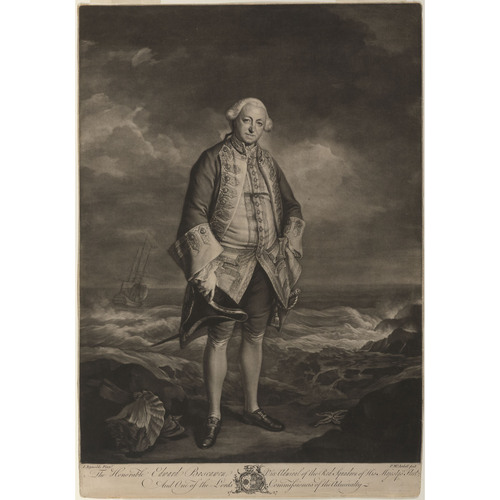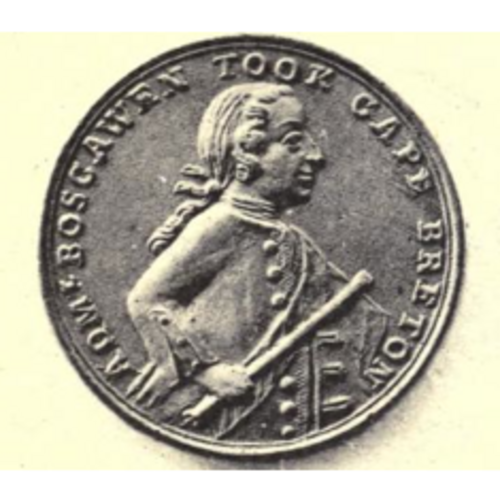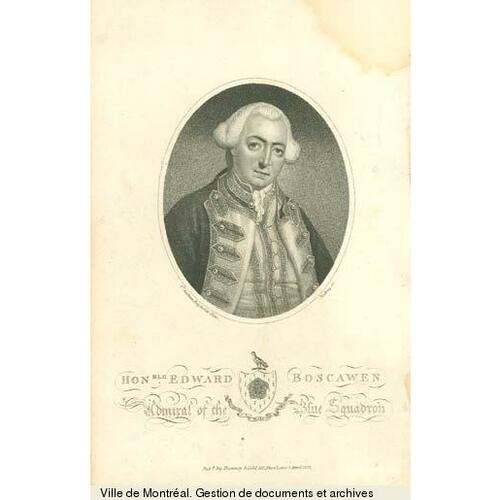
Source: Courtesy of Wikimedia Commons
BOSCAWEN, EDWARD, naval officer; sometimes called “Wry-necked Dick” from a habit of cocking his head to one side; more commonly known as “Old Dreadnought”; b. 19 Aug. 1711 to Hugh Boscawen, 1st Viscount Falmouth, and Charlotte Godfrey; m. 11 Dec. 1742 to Frances Evelyn-Glanville; d. 10 Jan. 1761 at Hatchland’s Park, Surrey, England. The Boscawens, of ancient lineage, derived their name from the family seat in Cornwall, Boscawen Ros (or, the valley of the elder trees). Edward’s maternal grandmother was Arabella Churchill, the Duke of Marlborough’s remarkable sister.
Edward Boscawen entered the navy as a volunteer in the Superbe (60 guns) on 3 April 1726, and became a midshipman 19 months later while serving in the West Indies. Except for the two and a half years in the Superbe his training was in home waters and the Mediterranean. He was promoted lieutenant in 1732, and given command of the 20-gun Leopard on 12 March 1737.
He was commanding the Shoreham (20 guns) in the West Indies when war began in 1739. He immediately proved himself an offensively minded and courageous leader. After distinguishing himself during the sieges of the Spanish strongholds at Porto Bello (Portobelo, Panama) and Cartagena (Colombia), he was elevated to the command of the 60-gun Prince Frederick. In this ship he left the West Indies, never to return, in May 1742. On 15 July 1747 he was made rear-admiral of the blue for continuous distinguished service. He had been wounded in the victory over the French fleet off Cape Finisterre, Spain, on 3 May 1747, but he recovered in time to take up an extraordinary and demanding appointment that autumn as commander-in-chief of an expedition to the East Indies. The siege of the French fort at Pondicherry (India) in 1748, although a failure, provided important experience for his task at Louisbourg, Île Royale (Cape Breton Island), in 1758.
On 12 May 1749 Boscawen was promoted rear-admiral of the white. He returned from the East in April 1750 and remained in England for the next five years. Made a member of the board of admiralty in 1751, he was close to the centre of political and naval affairs. On 4 Feb. 1755 he was promoted vice-admiral of the blue and given command of a squadron with secret orders to intercept all French reinforcements “as may annoy & endanger the safety of our colonies” in America. Since a state of war did not formally exist, conscious provocation such as this could be expected to have explosive and unpredictable results. Boscawen faced the possibility under highly unfavourable conditions. His fleet had been hastily gathered, and a number of his ships were manned with the sweepings of the streets, the press gangs not having found enough trained seamen. In the unfamiliar waters off Louisbourg he was beset by fogs and “the dismal prospect of floating islands of ice sufficient to terrifie the most daring seaman.” All but two of the French ships under Comte Dubois de La Motte [Cahideuc], slipped past the British squadron. So many men were dying from typhoid in Boscawen’s ships and so many were totally incapacitated by the disease that he had to sail for Halifax.
Arriving there on 9 July 1755, he could not avoid playing a part in the removal of the Acadians from Nova Scotia. He and his second in command, Rear Admiral Savage Mostyn, attended the council meeting of 28 July 1755 at which Charles Lawrence won approval for the deportation of the French inhabitants from Nova Scotia. By his presence alone, as commander-in-chief and a lord commissioner of the admiralty with well-known high connections, Boscawen could not have failed to exert some influence on the deliberations. Once the decision was made, the physical removal of the Acadians became a naval and military responsibility, and several captains under Boscawen’s command, including John Rous, participated.
Despite this less than heroic prologue to the Seven Years’ War, Boscawen was hailed on his return to England as “the Deliverer of America.” In 1756 he was promoted vice-admiral of the white and in 1757 vice-admiral of the red. He was the only member of the board of admiralty to retain office when the Newcastle government resigned in 1756. As the commander-in-chief, Portsmouth, he had to sign the order for the execution of Admiral Byng. He sailed in 1757 to command the blockading force off Brest, becoming second in command on the arrival of Admiral Edward Hawke.
In 1758 Pitt chose Boscawen to command the naval forces at the attack on Louisbourg. On 8 February he was promoted admiral of the blue and on 19 February sailed for Nova Scotia. Bad weather delayed the crossing, and the fleet did not reach Halifax until 9 May. Boscawen’s activities with respect to the capture of Louisbourg have been dismissed as merely providing the covering forces for a purely military operation. In fact he did much more. With Wolfe and Lawrence he worked out the first plan of attack (which Jeffery Amherst*, the military commander, later changed); conducted valuable training exercises in the landing of troops; made the decision to land the British forces and supported them with gunfire from his ships. During the siege, as he had learned to do at Pondicherry in 1748, he provided men and equipment both to support the infantry and to relieve the land forces from burdensome tasks. He landed at least four 32-pounder guns, a dozen 24-pounders, and several 6-pounders to support land operations. Gunners, sappers, carpenters, and pioneers came off the ships to participate in the siege. Boscawen even found in his squadron 188 miners who volunteered to dig entrenchments.
On 25 July, under his orders, Captains John Laforey and George Balfour successfully cut out the last two French ships in Louisbourg harbour capable of giving battle. On 26 July he got Amherst to agree to a combined attack by sea and land, but on the same day Drucour [Boschenry], the commandant, capitulated. As in 1745, combined naval and military operations had defeated the French garrison.
Since it was too late in the season to attack Quebec, Boscawen returned to England, having appointed Philip Durell to succeed him as senior officer at Halifax. For the rest of his naval career Boscawen was employed in the Mediterranean and in command of the Western squadron, which patrolled the “chops” of the English Channel. In 1759 he destroyed a French fleet in Lagos Bay, Portugal – the victory for which he is most often remembered. In 1760, despite abominable weather, he kept the Western squadron on its station. Worn out by continuous and trying sea service, in December 1760 he contracted a fever which proved fatal. He died in the home he had just built at Hatchland’s Park, Surrey. He was survived by his wife, whose letters comprise a charming record of their married life, and by five children.
Boscawen inspired the loyalty of his subordinates, demonstrated a fertile imagination, and, particularly in the Pondicherry and Louisbourg campaigns, made full use of the knowledge of his juniors. Like Nelson he possessed an offensive spirit in war and a rare concern for the welfare of common seamen. As his wife’s loving epitaph on his tomb at the church of St Michael Penkivel, Cornwall, claims, “with the highest exertions of military greatness he united the gentlest offices of humanity.”
PRO, Adm. 1/480, ff.627, 663; 1/481, f.41; 1/482; 50/3, Boscawen’s journals, 1755, 1758; CO 325. C. F. Aspinall Oglander, Admiral’s wife, being the life and letters of the Hon. Mrs. Edward Boscawen from 1719 to 1761 . . . (London, 1940). [Edward Boscawen], “Boscawen’s letters to his wife, 1755–56,” ed. P. J. Kemp, The Naval Miscellany (Navy Records Society pubs., XCII, London, 1952), IV. N.S. Archives, I. Charnock, Biographia navalis, IV. DNB. G.B., Adm., Commissioned sea officers, 1660–1815. J. S. Corbett, England in the Seven Year’s’ War: a study in combined strategy (2nd ed., 2v., London, 1918), I. Gipson, British empire before the American revolution, VI. D. S. Graham, “British intervention in defence of the American colonies, 1748–1756” (unpublished phd thesis, University of London, 1969), 309. G. S. Graham, Empire of the north Atlantic: the maritime struggle for North America (London, Toronto, 1950). McLennan, Louisbourg. H. W. Richmond, The navy in the war of 1739–48 (3v., Cambridge, Eng., 1920), I, III. J. M. Hitsman with C. C. J. Bond, “The assault landing at Louisbourg, 1758,” CHR, XXXV (1954), 314–30.
Cite This Article
W. A. B. Douglas, “BOSCAWEN, EDWARD,” in Dictionary of Canadian Biography, vol. 3, University of Toronto/Université Laval, 2003–, accessed December 21, 2025, https://www.biographi.ca/en/bio/boscawen_edward_3E.html.
The citation above shows the format for footnotes and endnotes according to the Chicago manual of style (16th edition). Information to be used in other citation formats:
| Permalink: | https://www.biographi.ca/en/bio/boscawen_edward_3E.html |
| Author of Article: | W. A. B. Douglas |
| Title of Article: | BOSCAWEN, EDWARD |
| Publication Name: | Dictionary of Canadian Biography, vol. 3 |
| Publisher: | University of Toronto/Université Laval |
| Year of publication: | 1974 |
| Year of revision: | 1974 |
| Access Date: | December 21, 2025 |








